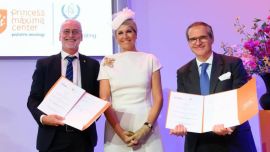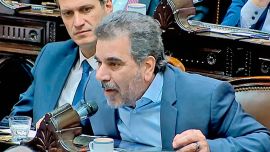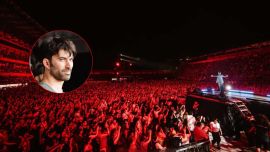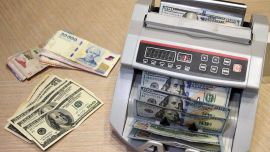The faces of Evita on the facades of a downtown Buenos Aires building, one smiling towards the south and the other frowning towards the north, sum up the constantly changing face of Peronism, the movement which has dominated Argentine politics and which is now struggling to avoid a historic electoral reverse in Sunday’s election.
So difficult to understand outside Argentina as it is to explain to those arriving in this country, Peronism has a birthday: it was born on October 17, 1945, the day on which the workers marched up from the suburbs to the south of the capital and ended up taking Colonel Juan Domingo Perón, the champion of social and labour reforms, to a presidency lasting almost a decade (1946-55).
Over half a century later, recent psychology graduate Nicolás Yugman, 27, finds Peronism to be something of "a contradiction."
"Perón in his different governments had different and contrary ideas. From the birth of Peronism until now ideas opposed to his own doctrine have been expressed under his banners," he said in an interview
‘Peronism invented Perón’
"Perón did not invent Peronism, Peronism invented Perón," explains historian Alejandro Horowicz, author of the book Los cuatro peronismos, when describing the origins of this movement which organised the working class and improved their wages in a country of incipient industrialisation.
Witness to Italian fascism in the 1930s, Perón pushed an "organised community" opposed to liberal democracy. His "national and popular" economic model redistributed wealth, enfranchised women and was repeatedly legitimised by the ballot-box.
The primal ideas of the Patrido Justicialista were summed up as "political sovereignty, economic independence and social justice," structured in three corporations: the state, the trade unions and businessmen, And with one leader: Perón.
The middle classes and the conservatives were opposed to the authoritarian régime into which Perón fell. In an Argentina steeped in political hatred, the opposition allied itself to the military to overthrow him violently in 1955 with the coup originating in the residences of the northern suburbs.
Right or left?
Argentina would remain polarised for various decades, during which Peronism, banned from elections, changed, adopting contradictory ideas.
Exiled in the Spain of the dictator Francisco Franco, who protected him, Perón appealed to the "resistance" of the trade unions and the "national liberation" of youth inspired by the Cuban revolution.
The leader returned in 1973, determined to regroup the party, but he died a year later in his third term, finally devoured by the violence of two extremes: the Montonero guerrillas, who preached "national socialism," and the paramilitary ‘Triple A’ (Alianza Anticomunista Argentina) group.
Always linked to strong leadership, the Argentines voted in the 1990s for a "fourth Peronism" under president Carlos Menem, who decided to promote "national unity" by embracing economic liberalism.
What is Peronism ‘K’?
Menem’s neoliberal experiment with privatisations and peso-dollar parity ended up in a grave crisis in 2001. Then came the "K" or “Kirchnerite” Peronists – Néstor Kirchner (2003-2007) and his wife Cristina Fernández de Kirchner (2007-2015) – confirming that Peronism retained one constant quality: that of ensuring governance.
The Kirchners returned to an active state role but the couple did not manage to create a "fifth Peronism," according to Horowicz, only opposing "a good capitalism to a bad capitalism."
"It was an attempt at progressive government with leftist roots” to take the country out of crisis, historian Felipe Pigna told AFP.
"But they committed a very serious error" in 2008, trying to raise agricultural taxation and confronting farmers, the motor of recovery. Like Perón in the 1950s, they ended up uniting almost all the opposition against them.
Does Peronism have a future?
"I feel that today Peronism no longer exists. They say Peronism but it’s more like Kirchnerism. Peronism is Perón, the old man who went before. The truth is I don’t really care," 15-year-old secondary school student Lucía Cardillo, 15, commented.
Again in power since 2019 with Alberto Fernández in the Presidency and Fernández de Kirchner as vice-president, a serious economic crisis with 40 percent below the poverty line has knocked the electoral base of Peronism.
"Peronism has become incapable of mutating," concluded Horowicz, writing: "It’s the long death throes of the fourth Peronism."
Convicted for corruption and after suffering an assassination attempt last year, Fernández de Kirchner, the last strong Peronist leader, has increasingly withdrawn from the political scene, finally deciding not to run for anything in these elections.
Instead, Peronism has found a circumstantial leader in Economy Minister Sergio Massa, who is barely grazing 30 percent of the vote in the first round of the presidential elections, according to the opinion polls.
Another Peronist leader, Buenos Aires Province Governor Axel Kicillof, has recognised: "We have to compose a new song. People are not listening to us."
But nobody imagines that its strong imprint can be erased.
"I don’t think that Peronism will disappear," underlines Pigna.
related news
by Eduardo de Miguel & Martín Raschinsky, AFP























Comments